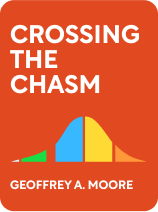

This article is an excerpt from the Shortform book guide to "Crossing the Chasm" by Geoffrey Moore. Shortform has the world's best summaries and analyses of books you should be reading.
Like this article? Sign up for a free trial here .
What is Geoffrey Moore’s chasm theory? How does Moore’s model differ from the traditional Technology Adoption Life Cycle?
According to the traditional Technology Adoption Life Cycle, customers smoothly and progressively transition from one stage of adoption to the next. However, according to Moore’s chasm theory, the psychographic differences between customers in each stage create gaps between each category, and the traditional TALC doesn’t account for those gaps.
In this article, we’ll take a look at how the characteristics of each category generate each of the gaps.
The Problem With the Traditional TALC
Moore explains that the traditional TALC assumes that sales to the five psychographic categories of customers transition seamlessly from one to the other as the technology matures. Sales in earlier categories build momentum, prompting adoption in the next category. This matters because maintaining sales momentum is the key to success.
(Shortform note: In The Tipping Point, Malcolm Gladwell expresses precisely this sentiment. He argues that the key to make an idea or product wildly successful is to build momentum until it reaches the “tipping point,” or “critical mass,” after which popularity growth becomes self-sustaining. Gladwell does not discuss the TALC, per se, as his book does not focus specifically on technological products, but his book nevertheless provides an example of the emphasis that marketers place on building momentum when promoting an idea or product in a contiguous population.)
However, according to Moore’s chasm theory, the categories don’t transition immediately from one to the next because the psychographic differences between the people in each stage of adoption create gaps between each category. Thus, Moore proposes a “Revised TALC,” which recognizes those gaps, as shown below. Because of the gaps, sales momentum in one category doesn’t necessarily carry over to the next.
Gap #1: The Application Gap Between Innovators and Early Adopters
Recall that, according to Moore’s characterizations, innovators value innovative technology for its own sake, while early adopters only value the benefits that innovative technology affords. Thus, the gap between innovators and early adopters represents the difference in technological maturity between presenting a new technology and showing that the new technology could actually be useful for something.
Moore notes that this gap is relatively small because early adopters tend to rely on innovators as references. Thus, if the innovators like your product, and the early adopters can think of beneficial uses for it, then this gap is easy to cross.
| Symptoms of Reaching the Application Gap How would you detect that your product has reached this gap? Moore doesn’t address this directly, but we can infer that the primary symptom of this gap would be feedback from prospective customers along the lines of, “That’s an impressive invention you’ve got, but what’s it actually good for?” |
Gap #2: The Chasm Between Early Adopters and the Early Majority
The most significant gap is what Moore calls the “chasm” between early adopters and the early majority. The gap is wide enough that Moore presents it as separating the population into two different markets: The “early market” is made up of innovators and early adopters, while the “mainstream market” is composed of the early majority, late majority, and laggards.
(Shortform note: In business, the term “early market” is used mostly in this sense, and most business dictionaries cite Moore’s book as the source of the term. The term “mainstream market,” however, is also used by others to refer to any large or broadly distributed market, in contrast to a “niche market,” which is smaller and more tightly connected.)
As Moore explains, early adopters are eager to adopt unproven cutting-edge technology because they want first-mover advantage, while the early majority want to mitigate the first-mover risk by waiting until the technology is well proven and well supported. The early majority also tend to rely on industry standards as a means of managing risk, and thus tend to favor industry-standard products.
Therefore, as Moore explains, early adopters tend to base their buying decisions on the perceived benefits of the product itself, while the early majority place more weight on the reputation of the manufacturer and/or distributor. Early adopters also communicate broadly with each other and with innovators, so they can reference innovators’ impressions of your product, but the early majority communicate more narrowly within their own community or industry, so they are unlikely to reference the impressions of innovators or early adopters.
| Symptoms of Reaching the Chasm The characteristic symptom of the chasm that Moore repeatedly cites is stagnant sales: When you first release your product, you may see exponential growth of sales in the early market, but then sales revenue hits a plateau or even trail off as the early market saturates and you enter the chasm. This is probably the symptom that drove most of Moore’s clients to seek his help in crossing the chasm, so it is understandable that he would cite it. However, from Moore’s description of the chasm, we can infer other symptoms as well. One symptom could be that coverage of your product in technology-oriented media sources has trailed off (because it’s no longer new enough to be technologically sensational) while business-oriented media sources aren’t interested in covering it yet (because your product or company doesn’t have enough market share to seem worthy of their attention). Another symptom could be increased inquiries about installation support, or availability of parts of the whole product besides the core technology that you supply. Recall that, when they purchase the core technology, early adopters are usually willing and able to take ownership of assembling the whole product, whereas the early majority expect the whole solution to be readily available. Thus, if you’ve run out of early adopters, such that most of your prospective customers are now from the early majority, they’ll be asking questions about the availability of the whole product (and not placing an order, when they find out you can’t supply the whole solution, leading to the stagnant sales we discussed earlier). Similarly, if a prospective customer asks whether your product meets certain industry standards or has certain certifications, that likely means the prospect is a member of the early majority. And if a high percentage of your prospects are asking these types of questions, that could be an indication you’ve run out of early adopters and have reached the brink of the chasm. |
The Catch-22 of the Chasm
According to Moore, the early majority won’t be comfortable buying your product until you build up a good reputation among other members of the early majority in their industry, but you can’t build up a reputation with them until they buy your products. By the same token, the early majority prefer to buy industry-standard products, but your product can’t become the industry standard until the early majority adopt it. This creates a catch-22 situation that makes it difficult to move your product across the chasm.
(Shortform note: Beal and Bohlen didn’t identify the chasm or discuss this catch-22 of innovation diffusion, but you can see the basis for it in their original paper: The early majority can’t afford to take risks on unproven technologies, but a new technology can’t be widely proven until they adopt it.)
Gap #3: The Competence Gap Between the Early and Late Majority
According to Moore, the gap between the early and late majorities is relatively small, and is driven by their differing levels of technological competence. Specifically, the late majority are less confident in their ability to learn and implement new technologies, so they need solutions that are more user-friendly. Thus the gap between these two categories divides people who need more support (late majority) from people who need slightly less (early majority—although they still need more support than the early adopters).
| Symptoms of Reaching the Competence Gap Moore doesn’t explicitly address how you identify when you’ve reached this gap, but once again we can infer some symptoms from his description. For one thing, based on the size and distribution of the categories, you won’t hit this gap until your product is the market leader, with about 50% of the market share. Another symptom could be a sharp uptick in the demand on your tech support department, as more customers with less technical competence start buying your product. Yet another symptom could be if you detect an assimilation gap: People are buying your product because of pressure to keep up with industry standards, but they aren’t actually using it, or aren’t taking advantage of its full capabilities. |
Gap #4: The Gap Between the Late Majority and the Laggards
Moore does not discuss the gap between the late majority and laggards, although he does show this gap on his revised TALC figure. Presumably he did not consider this gap worthy of discussion because crossing it has little bearing on the success of a company or product: The gap is small and the laggards offer limited sales potential anyway.
However, he does mention in passing that one of the few ways to sell new technology to laggards is to integrate it into something they already use without their realizing it.
For example, maybe you’ve developed a smart stock tank for ranchers that uses a microprocessor and an electronic valve to keep the water trough at a certain level, and allows the rancher to monitor water levels across all his tanks from his smartphone. The laggards want nothing to do with your new system: they will stick with their old-fashioned stock tanks that use mechanical float-activated valves. However, if you develop a model with a lifetime battery that can be deployed just like a regular mechanical stock tank, your distributor may be able to sell it to laggards as a “plain old self-filling stock tank,” even though it uses your electronic valve system and has wifi capabilities that they don’t realize and won’t use.
Thus, we might infer that the gap between the late majority and the laggards is one of visibility: To cross the gap into laggard territory, the technology has to mature to the point where it doesn’t look like a new technology anymore. If it looks just like the same old thing that everybody’s been using all along, then the laggards may cease to be averse to it.

———End of Preview———
Like what you just read? Read the rest of the world's best book summary and analysis of Geoffrey Moore's "Crossing the Chasm" at Shortform .
Here's what you'll find in our full Crossing the Chasm summary :
- An explanation of the chasm phenomenon that many new high-tech products face
- How to pilot a product across this chasm to mainstream success
- The problems with the Technology Adoption Life Cycle (TALC) model






